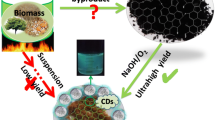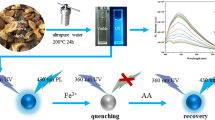Abstract
We introduce a simple, low-cost, and environment friendly method to obtain high-fluorescence carbon dots and activated carbon via a one-step hydrothermal process using banana peels. The dispersion of carbon dots generated strong, bright-blue photoluminescence (average diameter 3–6 nm), which could be further used in biosensing, electronics, and catalysis applications research. Moreover, the precipitation accumulated at the bottom of the hydrothermal process contained activated carbon with a highly porous structure and large specific surface area (294.6 m2 g−1), which could be used as a supercapacitor electrode. The three-electrode cell exhibited excellent capability and stability of the activated carbon as the working electrode in various aqueous electrolytes, with a high specific capacitance (199 F g−1) in an aqueous electrolyte (1-M KOH) and a high energy density of 54.15 Wh kg−1 at a current density of 0.5 A g−1. Thus, based on the excellent characteristics of the carbon dots and the strong electrochemical properties of the activated carbon as an electrode material, the banana peels, as an abundant bioresource, can provide two excellent produces.







Similar content being viewed by others
References
Hu B, Wang K, Wu L, Yu SH, Antonietti M, Titirici MM (2010) Engineering carbon materials from the hydrothermal carbonization process of biomass. Adv Mater 22(7):813–828
Herou S, Schlee P, Jorge AB, Titirici M (2018) Biomass-derived electrodes for flexible supercapacitors. Curr Op Green Sust Chem 9:18–24
Liang Y, Yang C, Dong H, Li W, Hu H, Xiao Y, Zheng M, Liu Y (2017) Facile synthesis of highly porous carbon from rice husk. ACS Sustain Chem Eng 5(8):7111–7117
Rufford TE, Hulicova-Jurcakova D, Khosla K, Zhu Z, Lu GQ (2010) Microstructure and electrochemical double-layer capacitance of carbon electrodes prepared by zinc chloride activation of sugar cane bagasse. J Power Sources 195(3):912–918
Sun L, Tian CG, Li MT, Meng X, Wang L, Wang R, Yin J, Fu H (2013) From coconut shell to porous graphene-like nanosheets for high-power supercapacitors. J Mater Chem A 1(21):6462–6470
Guo N, Li M, Wang Y, Sun X, Wang F, Yang R (2016) Soybean root-derived hierarchical porous carbon as electrode material for high-performance supercapacitors in ionic liquids. ACS Appl Mater Interfaces 8(49):33626–33634
Gao Z, Zhang Y, Song N, Li X (2017) Biomass-derived renewable carbon materials for electrochemical energy storage. Mater Res Lett 5(2):69–88
Wang J, Nie P, Ding B, Dong S, Hao X, Dou H, Zhang X (2017) Biomass derived carbon for energy storage devices. J Mater Chem A 5(6):2411–2428
Deng J, Li M, Wang Y (2016) Biomass-derived carbon: synthesis and applications in energy storage and conversion. Green Chem 18(18):4824–4854
Wang Y, Hu A (2014) Carbon quantum dots: synthesis, properties and applications. J Mater Chem C 2(34):6921–6939
Zhang J, Yu SH (2016) Carbon dots: large-scale synthesis, sensing and bioimaging. Mater Today 19(7):382–393
Wu ZL, Liu ZX, Yuan YH (2017) Carbon dots: materials, synthesis, properties and approaches to long-wavelength and multicolor emission. J Mater Chem B 5(21):3794–3809
Sahu S, Behera B, Maiti TK, Mohapatra S (2012) Simple one-step synthesis of highly luminescent carbon dots from orange juice: application as excellent bio-imaging agents. Chem Commun 48(70):8835–8837
Thambiraj S, Shankaran DR (2016) Green synthesis of highly fluorescent carbon quantum dots from sugarcane bagasse pulp. Appl Surf Sci 390:435–443
Qin X, Lu W, Asiri AM, Al-Youbi AO, Sun X (2013) Microwave-assisted rapid green synthesis of photoluminescent carbon nanodots from flour and their applications for sensitive and selective detection of mercury(II) ions. Sensors Actuators B 184:156–162
Jia X, Li J, Wang E (2012) One-pot green synthesis of optically pH-sensitive carbon dots with upconversion luminescence. Nanoscale. 4(18):5572–5575
Wang F, Wu X, Yuan X, Liu Z, Zhang Y, Fu L, Zhu Y, Zhou Q, Wu Y, Huang W (2017) Latest advances in supercapacitors: from new electrode materials to novel device designs. Chem Soc Rev 46(22):6816–6854
Padam BS, Ti HS, Chye FY, Abdullah MI (2014) Banana by-products: an under-utilized renewable food biomass with great potential. J Food Sci Technol 51(12):3527–3545
Xue M, Lu W, Chen C, Tan Y, Li B, Zhang C (2019) Optimized synthesis of banana peel derived porous carbon and its application in lithium sulfur batteries. Mater Res Bull 11:269–280
Rajesh M, Veeramani V, Chen S-M (2014) Heteroatom-enriched and renewable banana-stem-derived porous carbon for the electrochemical determination of nitrite in various water samples. Sci Rep 4:4679
Niya AA, Rufford TE, Zhu Z (2016) Nitrogen-doped carbon foams synthesized from banana peel and zinc complex template for adsorption of CO2, CH4, and N2. Energy Fuel 30:7298–7309
Fasakin O, Dangbegnon JK, Momodu DY, Madito MJ, Oyedotun KO (2018) Synthesis and characterization of porous carbon derived from activated banana peels with hierarchical porosity for improved electrochemical performance. Electrochim Acta 262:187–196
Atchudan R, Edison TNJI, Perumal S, Muthuchamy N, Lee YR (2020) Hydrophilic nitrogen-doped carbon dots from biowaste using dwarf banana peel for environmental and biological applications. Fuel. 275:117821
Du Y, Guo S (2016) Chemically doped fluorescent carbon and graphene quantum dots for bioimaging, sensor, catalytic and photoelectronic applications. Nanoscale. 8(5):2532–2543
Roy P, Chen PC, Periasamy AP, Chen YN, Chang HT (2015) Photoluminescent carbon nanodots: synthesis, physicochemical properties and analytical applications. Mater Today 18(8):447–458
Zequine C, Ranaweera CK, Wang Z, Singh S, Tripathi P, Srivastava ON, Gupta BK, Ramasamy K, Kahol PK, Dvornic PR, Gupta RK (2016) High per formance and flexible supercapacitors based on carbonized bamboo fibers for wide temperature applications. Sci Rep 6:31704
Liu M, Xu Y, Niu F, Gooding JJ, Liu J (2016) Carbon quantum dots directly generated from electrochemical oxidation of graphite electrodes in alkaline alcohols and the applications for specific ferric ion detection and cell imaging. Analyst. 141(9):2657–2664
Chen W, Hu C, Yang Y, Cui J, Liu Y (2016) Rapid synthesis of carbon dots by hydrothermal treatment of lignin. Materials. 9(3):184
Lu W, Qin X, Asiri AM, Al-Youbi AO, Sun X (2013) Green synthesis of carbon nanodots as an effective fluorescent probe for sensitive and selective detection of mercury(II) ions. J Nanopart Res 15(1):1344
Feng J, Wang WJ, Hai X, Yu YL, Wang JH (2016) Green preparation of nitrogen-doped carbon dots derived from silkworm chrysalis for cell imaging. J Mater Chem B 4(3):387–393
Sudhan N, Subramani K, Karnan M, Ilayaraja N, Sathish M (2017) Biomass-derived activated porous carbon from rice straw for a high-energy symmetric supercapacitor in aqueous and non-aqueous electrolytes. Energy Fuel 31(1):977–985
Li Y, Zhang Q, Zhang J, Jin L, Zhao X, Xu T (2015) A top-down approach for fabricating free-standing bio-carbon supercapacitor electrodes with a hierarchical structure. Sci Rep 5:14155
Liu X, Zhou Y, Zhou W, Li L, Huang S, Chen S (2015) Biomass-derived nitrogen self-doped porous carbon as effective metal-free catalysts for oxygen reduction reaction. Nanoscale. 7(14):6136–6142
Lu B, Hu L, Yin H, Xiao W, Wang D (2016) One-step molten salt carbonization (MSC) of firewood biomass for capacitive carbon. RSC Adv 6(108):106485–106490
Ma F, Wan J, Wu G, Zhao H (2015) Highly porous carbon micro flakes derived from catkins for high-performance supercapacitors. RSC Adv 5(55):44416–44422
Xie L, Sun G, Su F, Guo X, Kong Q, Li X, Huang X, Wan L, song W, Li K, Lv C, Chen CM (2016) Hierarchical porous carbon microtubes derived from willow catkins for supercapacitor applications. J Mater Chem A 4(5):1637–1646
Wu D, Cheng J, Wang T, Liu P, Yang L, Jia D (2019) A novel porous N- and S-self-doped carbon derived from chinese rice wine lees as high-performance electrode materials in a supercapacitor. ACS Sustain Chem Eng 7(14):12138–12147
Zhao G, Li Y, Zhu G, Shi J, Lu T, Pan L (2019) Biomass-based N, P, and S self-doped porous carbon for high-performance supercapacitors. ACS Sustain Chem Eng 7(14):12052–12060
Mao L, Zhang Y, Hu Y, Ho KH, Ke Q, Liu H, Hu Z, Zhao D, Wang J (2015) Activation of sucrose-derived carbon spheres for high-performance supercapacitor electrodes. RSC Adv 5(12):9307–9313
Wang J, Ding B, Xu Y, Shen L, Dui H, Zhang X (2015) Crumpled nitrogen-doped graphene for supercapacitors with high gravimetric and volumetric performances. ACS Appl Mater Interfaces 7(40):22284–22291
Maiti S, Das AK, Karan SK, Khatua BB (2015) Carbon nanohorn-graphene nanoplate hybrid: an excellent electrode material for supercapacitor application. J Appl Polym Sci 132(25):42118
Fan LQ, Zhong J, Wu JH, Lin JM, Huang YF (2014) Improving the energy density of quasi-solid-state electric double-layer capacitors by introducing redox additives into gel polymer electrolytes. J Mater Chem A 2(24):9011–9014
Author information
Authors and Affiliations
Corresponding author
Ethics declarations
Conflict interest
The authors declared no potential conflicts of interest with respect to the research, authorship, and/or publication of this article.
Additional information
Publisher’s Note
Springer Nature remains neutral with regard to jurisdictional claims in published maps and institutional affiliations.
Rights and permissions
About this article
Cite this article
Nguyen, T.N., Le, P.A. & Phung, V.B.T. Facile green synthesis of carbon quantum dots and biomass-derived activated carbon from banana peels: synthesis and investigation. Biomass Conv. Bioref. 12, 2407–2416 (2022). https://doi.org/10.1007/s13399-020-00839-2
Received:
Revised:
Accepted:
Published:
Issue Date:
DOI: https://doi.org/10.1007/s13399-020-00839-2




